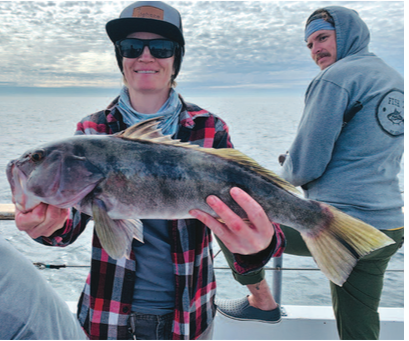BY MERIT McCREA
The bass bite has been pretty consistent this winter so far on leadhead and squid and on the swimbait. Reaching back into the past, I’ve seen some of the best bites of the year hap- pen in the coldest waters, even 55 degrees one February.
I’m not sure how it happens, but it does. Perhaps when big swells come and tear up the kelp, the bass all concentrate on the best hard bottom spots. Who knows?
Fishing bass on plastic in warm water most often means fishing for a bite on the drop, then slow and steady on the grind if you miss. This time of year the strategy is fishing tight to the bottom, often a slow crawl, really slow, just popping the plastic from rill to rill.
In colder waters, what hap- pens is it’s not so much the wa- ters are cold, but there is no lay- er of warm water above the per- sistent cold stuff at depth. It’s all cold, top to bottom, not just on the bottom.
With that, not only are the fish simply slower, but there’s no reason to hang high in the water column – it’s gonna be cold no matter what.
Back in the day, some of the first swimbaits were things like the Clout, even the Hoochi- toad. Then there was the twin- tail revolution and Scampis.
We’d drag the big ones on the bottom in 60 feet of water, baited with a strip of mackerel, and giant sand bass would pick them off. After that came Mar- vin’s too-soft WormKings, which worked well despite Mar- vin himself not being the best at fishing them.
But when FishTrap hit the waters with just the right tooth to keep fish hanging on but not instantly tearing it in half on the first taste, they took over. MC Swimbaits too, and perhaps the most well known and consistent produc- er, Big Hammer.
Now the saltwater-sized tube baits are in the mix, with Hookup Baits getting lots of soak time. Others have gone tubular too and there are several bait makers breaking into the scene.
Working close to the bottom with the plastic can be treacher- ous. Weedless heads can be al- most essential, especially when fishing places like the Federal Breakwaters off Long Beach and L.A. harbors.
When Izorline’s Wendy Tochihara first suggested we fish there, not knowing much else other than it was smack dab in the middle of one of the largest population centers on planet earth, I assumed it would be pretty picked over, all well educated pee-pee bass at best – time to fish the tiny stuff on light line.
She insisted otherwise, sug- gested 65-pound braid, 40- pound fluoro or straight braid, and a weedless leadhead. Fish- ing it on a cold winter night, she was right.
I got bit and was instantly tooled on my lighter tackle. Af- ter that, it was straight braid.
The strategy was to toss in tight and be prepared to cut some kelp. Bounce the bait down the face of the boulders.
Calicos came shallow, sand bass bit deeper. Swing hard and grind fast.
It’s the same on open-water structure. Bites can be subtle but when bit you have to com- mit, swing for the stands and TURN THE HANDLE!
Lots of times you’ll catch nothing but air. There’s no shame in that. What the is shame in is having your hand bumped off the handle when you get bit, or lifting the rod high without winding and end- ing up instantly rocked.
Sometimes you’ll swing and there will be nothing there, not even your offering, sliced clean like by a knife. Can’t really help that either.
Tackle manufacturers gotta make a living too.
There’s also no shame in stick- ing a strip of squid on the thing, so long as you’re not fishing an artificials-only tournament.
Deep hammering the swim- bait for sculpin is another pro-
ductive strategy – dropper- looped swimbait. Drop-shotting also works well, a weedless worm hook with a swimbait tail above a torpedo sinker.
A favorite is artificial struc- ture – artificial reefs, either in- tended or incidental. Such structures, by their nature tend to have more “interstitial space,” which is what bass love in a reef – inside space.
Intended reefs are like Izor’s off Huntington or the many ARs along the Santa Monica coastline. Incidental stuff in- cludes the rip-rap reefs of rock revetment holding pipelines in place against the elements.
But, some ARs (Izors) are lethal tackle and anchor grab- bers. A dive down into the 90- foot depths revealed why.
On the meter, some top out at nearly 85 feet in places. But what we Love Lab divers found was it’s a fake. At 87 feet was the top of the pile of gargantuan Pick-Up Sticks.
But from there we could see clean, white sand at 100, be- tween the tangled 30-foot-long, 18-inch diameter beams some dozen feet below us. In between, buff sheephead and burly sand bass cruised slowly by.
If you bounce your swimbait down between those and get bit, you’re in for a tussle, one which will be won or lost in sec- onds. Although it make take up to 10 minutes to finally figure out… yep, ya lost…
Merit McCrea is saltwater edi- tor for Western Outdoor News. A veteran Southern California par- tyboat captain, he is a marine re- search scientist with the Dr. Mil-
ton Love Lab at the University of California at Santa Barbara’s Marine Science Institute. He serves on the Groundfish Adviso- ry sub-Panel of the Pacific Fish- eries Management Council, the Santa Barbara Harbor Commis- sion, The Channel Islands Na- tional Marine Sanctuary Advisory Council and the CCA-Cal State Board. He can be reached at: merit@wonews.com.




